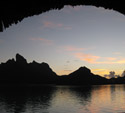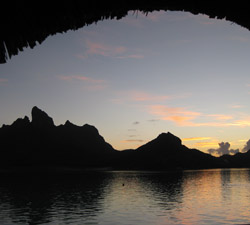South Pacific

 It’s Not Just Nice, it’s Paradise
It’s Not Just Nice, it’s Paradise
Since he was seven years old he knew he wanted to spend his life at sea. Now at the tender age of 54 Captain Toni Mirkovic is plying the breathtaking waters of the South Pacific at the helm of the award winning luxury cruise ship, Paul Gauguin. Unlike Captain Bligh of the ill-fated Bounty, Captain Mirkovic has gained the respect of his 217 crew and the confidence of his 330 grateful guests. On an eight day cruise in March, we visited the Society Islands of French Polynesia , an eight hour Air Tahiti Nui flight south west from Los Angeles, landing in a pocket of the Pacific Ocean seemingly at the very end of the earth. But it proved to be the pot of gold at the end of the rainbow. Quoting Mirkovic, “when I saw the Society Islands from the air I fell in love with French Polynesia…you can’t describe the beauty of this area.”
Well, I’m going to try. Moorea is a perfect start. My first glimpse of this island was at 7:15 am while on the bridge with the Captain as the ship cruised quietly into history. The morning mist gave way to Opunohu Bay – scene of the movie Bounty recreating Bligh’s first meeting with the Polynesian natives. Two towering mountains bracketed the bay acting as a dramatic backdrop to a flotilla of colourful sailboats at ease in the aquamarine lagoon. What first came to mind was the lushness of Moorea. It was the rainy season and the coconut, breadfruit and pandanus leaves waved us on and the intoxicating fragrance of indigenous flowers – tiare, hibiscus and frangipani – perfumed the air. Since the Paul Gauguin was anchoring overnight, guests had two days to explore. One group went with the ship’s guest lecturer, a charismatic anthropologist from New Zealand. We travelled deep into the interior of this ancient volcanic island, home to marae or burial sites of the early Polynesians; we explored rain forests filled with giant vegetation and plucked a few pineapples from vast fields filled with groves. Then just as we were leaving, the sun came out on cue and we gazed upon perhaps the most famous peak on the island, Mouaroa, better known to many as James Michener’s ‘Bali Hai’.
Back on board I rested in my quiet and cozy stateroom with its seventy square foot balcony, luxuriously appointed beds and ample bathroom. The day’s trek worked up quite an appetite. Each of the three restaurants offered food of staggering variety and creative presentation. After dinner entertainment included performances by Les Gauguines – bronzed beauties with long luxurious black hair seductively dancing to traditional Polynesian music – named after the artist Gauguin who immortalized the natives and their islands.
On the tiny, exquisite island of Taha’a, a 20-minute boat ride from Raiatea (second largest of the Society Island, after Tahiti), a few of us decided to visit a black pearl farm. The black pearl is pure gold to the Polynesians. It’s one of their most important exports and its creation is a coveted secret. According to the owner, the only person who knows how to surgically implant the living black lipped Polynesian oyster with the right ‘grit’ is an expert from Japan. Once the procedure is completed, our host tends the water garden of 20,000 oysters and explains that it takes almost two years for one oyster to produce a quality pearl. (The largest he ever farmed was 19 mm in size and he promptly sold it for $30,000 US. )
French Polynesia is not cheap. The pearls are no exception. Expensive shops selling rare pearls are found on most islands and the cheaper versions can be bought at the covered stands and stalls in the markets by the main ports of call. These are manned by older Polynesian women, dressed in their traditional brightly coloured clothes who do a brisk trade selling them as well as handmade soaps, hand-carved wood items and ukuleles – a well-loved instrument on the islands.
Every sailor worth his salt knows that the Polynesians were master navigators; when we neared the island of Raiatea, a group of young men raced by in long, double-hulled canoes as fast as arrows shot from the sea. It was a spectacular sight as these canoes glided by motus (or miniature islands) strung like pearls along the horizon suffused in pinks and turquoises by the setting sun.
We had a chance to spend a sunny day on one of them. A tiny Robinson Caruso island, with the requisite palm trees, white sandy beaches, where the ship’s staff provided traditional Polynesian food: breadfruit, a variety of local fish cooked in coconut oils and vanilla-laced desserts. Snorkelling, water skiing, swimming and sitting in the warm waters were the preferred sport of the day.
Water takes on a new meaning here. It’s almost spiritual. The water god of legend painted the lagoons with the help of his brother, the sun god. Their combined palette, like two old masters, can’t be replicated. The temperature is usually around 80 plus degrees and even in the rain it never feels uninviting.
The water god lured us again the following day when we reached Bora Bora (or as the Polynesians say, Pora Pora…their language is so soft to the ear that harsh consonants are never heard).
Time to feed the stingrays and black tipped sharks on the island’s famous lagoon. Patrick, our loin-clothed and tattooed master of the motorboat whisked another group of us away for an afternoon of snorkelling. Coral reefs and their colourful inhabitants captivated us for hours. Patrick gave each of us a handful of shrimp which resulted in the most astonishing display of wave after wave of stingrays literally brushing their velvety bodies against ours and in the near distance a trio of sharks gathered but were less curious than their fellow sea mates much to our relief (or perhaps just mine).
Another watering hole we didn’t miss was Bloody Marys. We rewarded ourselves for our shark adventure with the eponymous drinks at the bar and restaurant overlooking the lagoon. The walls supporting the thatched roof are covered with pictures of the rich and famous who drank there including Marlon Brando, whose original home is still on the Bora Bora, next to actor Jack Nicholson’s.
Bora Bora provides innumerable opportunities for adventure: circle the island by Waverunner; take an off road trek to visit cannons still standing in their original WW11 locations or bunkers constructed by American GIs; rent a glass-bottom boat to enjoy protected views of the lively sea creatures; go diving deep in a submarine or fly high with a helicopter; or, take a leisurely sail visiting the charming and unpopulated bays.
Our final destination was the harbour of Society Islands largest, Tahiti. It’s the only commercialized island of the group. The market by the harbour of its capital, Papeete is a must for souvenir hunters….mounds of shells, pearls, paraes (hand printed cotton cloths), woven baskets, fresh fruit and fish comingle. A French atmosphere pervades the labyrinth of streets behind the market where the smell of good coffee and freshly baked croissants and pain au chocolat inevitably lure you in.
I stayed for only one night at the InterContinental Resort by the sea so I didn’t have a chance to visit the Gauguin Museum, and the many handcraft galleries scattered throughout the island. Next time.
But another delight beckoned. I boarded Air Tahiti that day and flew back to Bora Bora (40 minute flight) to spend several days at the Four Seasons Resort. In a word…heaven. Seven beachfront villas and one hundred thatched roof bungalows perch on stilts hovering over the tranquil lagoon and presided over by a bewitching Mount Otemanu. Let’s just say that my bungalow made me want to stay there forever; all the amenities one could possibly wish for in a five-star resort including snorkelling gear on my private deck for quiet morning swims before breakfast on my terrace. As luck would have it the sun god reined and nary a drop of water from the silenced rain god. The resort is an inspired creation. Children’s day care with miniature sinks for short legged kiddies, a teenage private lagoon area with coral reefs, even a chapel for all those love birds. But for me it was the spa. Virtuoso Life magazine crowned it number one spa in the world. It’s built like a ‘temple to wellness’ with the Pacific Ocean as the backdrop and the impossibly blue lagoon in front; tranquility pools and glass windows in the floor beneath the treatment beds to watch tropical fish as your body is polished with black-pearl powders ; bathing in outdoor tubs filled with coconut milk and tiare petals. Priceless.
There is no question that vacationing in French Polynesia was a dream come true. Besides the beauty and exotic nature of the trip, the Polynesian people were especially gentle, generous and proud. Their past is colourful indeed but their future may be a victim of global economies that threaten to change their remarkable culture and pristine, natural beauty.
Now is the time to visit the land of Paradise even in the rainy season. Some dreams are worth preserving and pursuing.




























